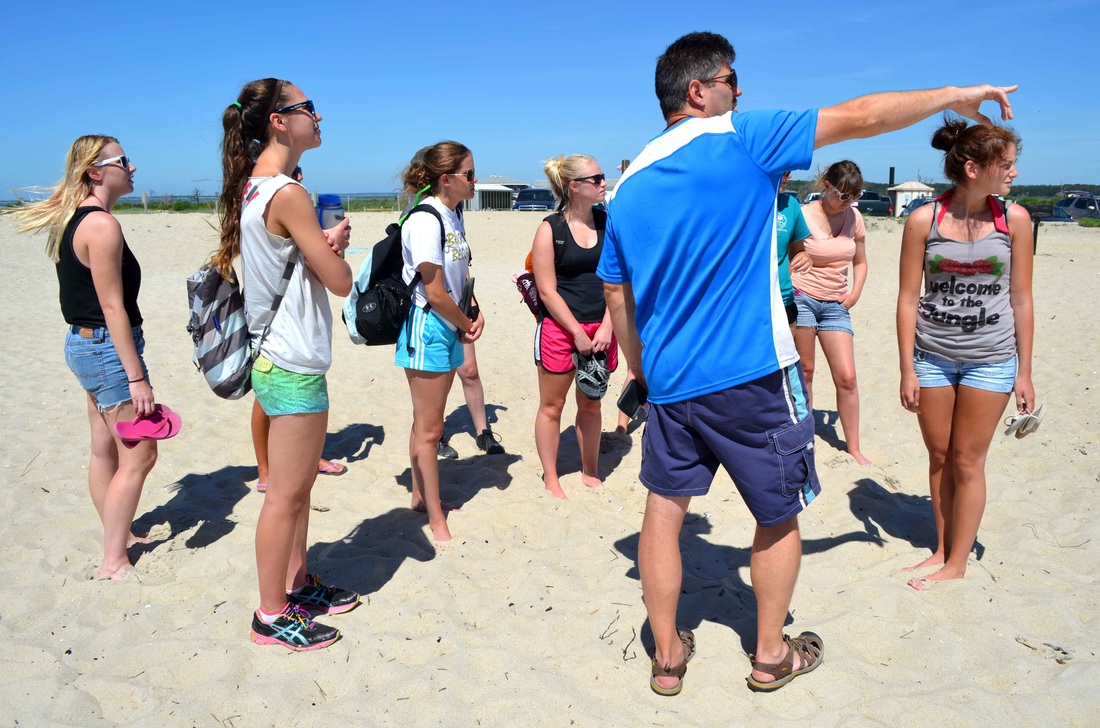|
Students in the Conservation Biology class have spent the past two weeks learning about the ecology and genetics applied to populations of rare and endangered species, and the conservation methods used to support these animals. Last Friday the students had a unique opportunity to meet with managers of both public and private lands to learn about the practical application of conservation biology. The Eastern Shore is an ideal place to study conservation biology because of the intersection of a variety of endangered, invasive, and native species which makes for an often times unbalanced ecosystem which requires human intervention. To learn about the ways that the Chincoteague National Wildlife Refuge works to conserve, the Conservation Biology students took a trip to hear from Kevin Holcomb, a supervisory wildlife biologist at the Refuge who has worked for the U.S. Fish and Wildlife Service for more than 18 years. Dr. Haines of Millersville University, who has been teaching classes at the Field Station for three years, was an intern at the wildlife refuge in 2000 and was able to supplement Kevin Holcomb’s experiences with his own. Holcomb discussed the intricacies of conservation at the refuge, which is one of the top five wildlife refuges in the country in visitation. The lecture, entitled “Refuge Management in a Rapidly Changing Landscape,” discussed what the refuge was working hard to conserve and why. Chincoteague is home to many different plants, insects, birds, and mammals that impact its ecology – aside from the humans that are constantly affecting change in the area. The refuge applies multiple-use management in order to maximize conservation of the environment with things like public use and cultural resources, like the Assateague Lighthouse. Part of this plan includes population control of the animals: for the endangered animals, monitoring their size, and for invasive species, monitoring their growth. An example of invasive species in the area is the sika elk, originally from Asia, which were released onto the island by a Boy Scout troop in the early 1990’s. The refuge allows people to hunt the sika elk in order to stunt their rapidly growing population that is presently infringing on the population of the white-tailed deer. Another example of a species affecting the environment is the southern pine beetle. While this small critter is native to the Eastern Shore, it is not necessarily less harmful than the sika population. These beetles are making their way into trees, causing them to collapse which could be dangerous to other animals and also affects the recreational experience of hikers. After the informative lecture by Kevin Holcomb, Dr. Haines brought his students over to the Assateague Island beach to discuss the Refuge’s future. U.S. Fish & Wildlife Service is currently working on implementing their Comprehensive Conservation Plan (CCP) which will include moving the recreational access, or beach site, a mile and a half down the shoreline. Although this is a conservation measure to prevent the cycle of spending money to renovate the visitor’s center every time a storm hits, it’s taken a while for everyone to get on board. The class talked about different obstacles that the wildlife refuge has in order to successfully maximize conservation, and why it’s critical for the future of the island.
0 Comments
Leave a Reply. |
About
Everything you need to know about CBFS's educational programs, visiting Chincoteague Island, and more! Categories
All
Archives
January 2019
|
CHINCOTEAGUE BAY FIELD STATION | 34001 Mill Dam Road | Wallops Island, VA 23337 | (757) 824-5636 | [email protected]






 RSS Feed
RSS Feed

